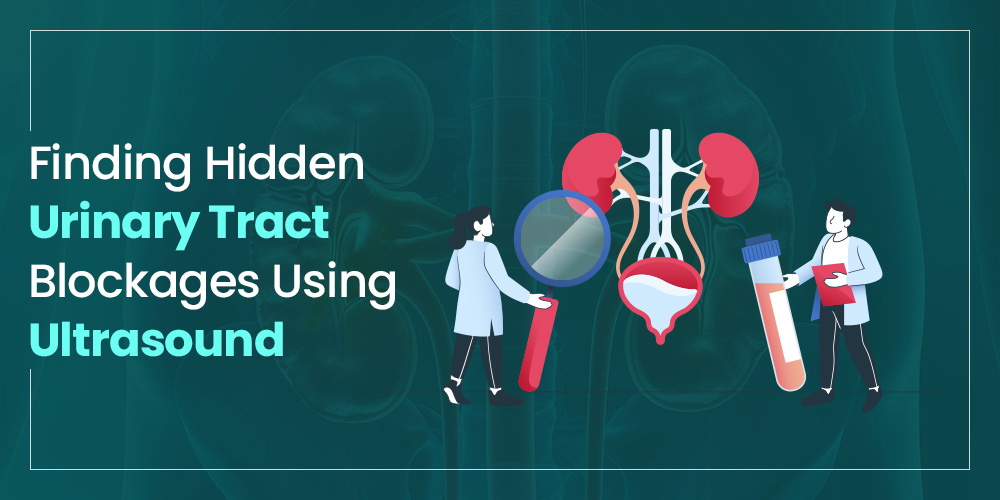Urinary Tract blockages or Ureteral Obstruction are hindrances to your regular urinary flow. This blockage of urine does not pass out of your body but back into your system.
Studies show that Urinary tract blockages affect all age groups, but most cases are present in infants and the elderly.
Urinary tract obstructions are a significant health concern, which if left untreated can cause severe pain, infection, and Hydronephrosis. Diagnosing these blockages early is vital for effective treatment and maintaining good health.
One of the most effective tools for diagnosing blockage of urine is Ultrasound. This non-invasive, painless imaging technique allows healthcare providers to visualize the urinary tract and detect any obstructions that might be present.
What Is an Ultrasound? — A Closer Look
Ultrasound, also known as Sonography, employs high-frequency sound waves to develop images of the inside of the body. A small specialized device called a Transducer emits sound waves that reflect tissues and organs, creating echoes. These are then converted into visual images by a computer.
These visual images provide detailed information about the structure and function of the urinary tract, including the kidneys, bladder, and ureters (the tubes that carry urine from the kidneys to the bladder).
Detecting Urinary Tract Blockages with Ultrasound: Here’s Why?
Ultrasound is ideal for detecting obstruction in the urinary tract for diverse reasons. Following are some of those reasons listed to you:
● Non-Invasive: Ultrasound for kidney stones does not require incisions or injections, unlike some diagnostic procedures. This makes it a safer and more comfortable option for patients to opt for.
● Radiation-Free: Unlike X-rays and CT scans, Ultrasound employs non-ionizing radiation. This makes it a safer option, especially for frequent usage.
● Real-Time Imaging: Ultrasound for renal stones provides real-time images, allowing healthcare providers to observe the urinary tract in motion and identify blockages as they happen.
● Versatility: Evaluates different parts of the urinary tract, from the kidneys to the bladder, making it a comprehensive tool for diagnosis.
How To Choose An Ultrasound?
Selecting the correct ultrasound machine is crucial for accurate diagnosis and effective treatment of renal tract obstruction. Here are some key factors to consider when choosing an ultrasound for kidney stones:
● Image Quality: Look for an ultrasound system that offers superior image quality, with clear and detailed visuals of the kidneys, bladder, and ureters.
● Accessibility: A user-friendly interface and intuitive controls are important for efficient operation. Systems that are easy to navigate can reduce the time needed for training and improve the overall workflow.
● Portability: Portable ultrasound machines are beneficial for use in various clinical settings. Consider a compact and lightweight system if mobility is a priority.
● Reliability and Durability: Investing in a reliable and durable ultrasound machine ensures long-term performance and reduces maintenance costs. Look for systems from reputable manufacturers known for quality and reliability.
● Advanced Features: Modern ultrasound systems come with a range of advanced features, such as 3D/4D imaging and automated measurements. These features can enhance diagnostic accuracy and provide additional insights into the condition of the urinary tract.
Working Mechanism of Ultrasound Imaging
During an ultrasound exam, the patient lies on an examination table probably with a full bladder. A healthcare provider begins the procedure by applying a special gel to the skin over the area being examined. This gel helps transmit the sound waves from the transducer into the body. Followed by that, the healthcare provider then moves the Transducer over the skin, capturing images of the urinary tract.
In cases of urinary tract obstruction, the Ultrasound reveals several signs. These signs are as follows:
● Urinary Tract Dilation: Blockages can cause the urinary tract to swell up or dilate upstream from the obstruction. This is often visible on ultrasound images.
● Presence of Stones or Tumors: Renal Ultrasound for kidney stones can detect the presence of kidney stones, tumors, or other masses that might be causing a blockage.
● Changes in Kidney Size or Shape: Chronic blockages can lead to changes in the size or shape of the kidneys, which can also be detected with ultrasound.
Why Early Detection Matters?
Early detection of obstruction in the urinary tract is significant to prevent complications in the future. Prolonged blockage of urine can lead to infections, severe pain, or damage to your kidneys potentially leading to kidney failure.
This trapped urine becomes a breeding ground for bacteria resulting in urinary infections and kidney stones.
According to the National Institute of Diabetes and Digestive and Kidney Diseases (NIDDK), kidney stones affect about 11% of men and 6% of women in the United States during their lifetime.
Thus early detection through ultrasound can significantly improve treatment outcomes and prevent severe complications.
Advanced Ultrasound Technology
Modern ultrasound technology has made significant strides in enhancing the accuracy and convenience of urinary tract imaging.
In India, the demand for high-quality ultrasound machines has grown significantly due to their affordability and efficiency. The ultrasonography machine price varies depending on the features and brand.
There are companies that offer advanced ultrasound systems designed for high-quality imaging and ease of use. These products provide clear, detailed images that help healthcare providers make accurate diagnoses and treatment decisions.
To buy best ultrasound machine in India get in touch with the team of Trivitron Healthcare, a leading medtech organization.

